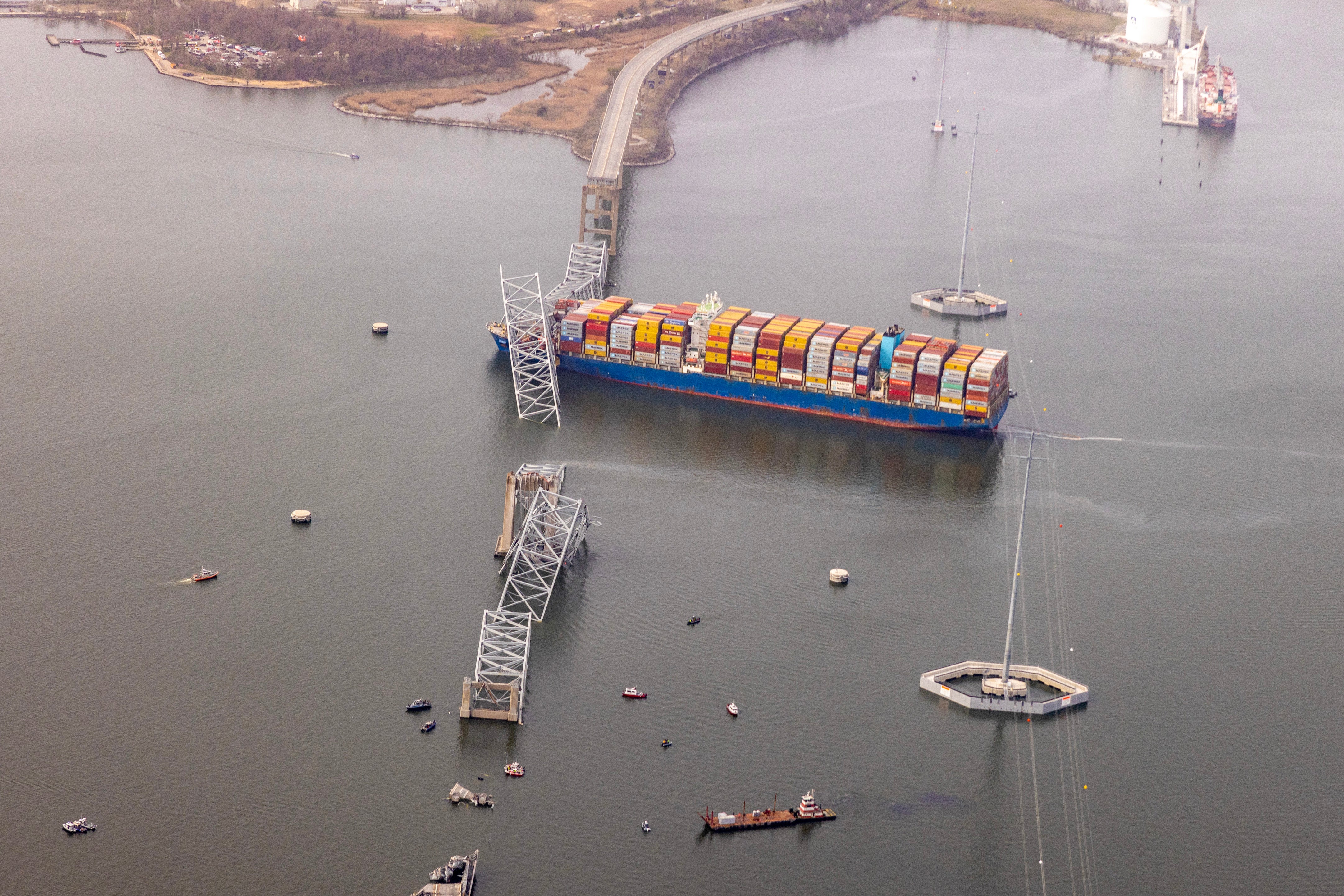Early Tuesday morning, at around 1:30 a.m., a 948-foot-long cargo ship left the Port of Baltimore and headed toward open water, en route to Sri Lanka. Within minutes, the ship slammed into a pillar holding up the Francis Scott Key Bridge, causing its superstructure to tumble into the Patapsco River. Rescuers rushed to the bridge and plucked at least two people from the water, one in critical condition. As of midday Tuesday, at least six highway workers were missing.
Saving lives is (and should be) the immediate priority. But the shocking incident raises other concerns too. The destruction of the bridge, a part of Baltimore’s Interstate 695 beltway, could seemingly doom Marylanders to hellish gridlock for the foreseeable future. Early on Tuesday, the New York Times noted that “multiple news anchors [have] suggested the morning commute will be disastrous for thousands of drivers.” WJZ News, Baltimore’s local CBS station, warned, “The impacts are going to be felt not only here in the local neighborhoods but for all of those people who normally don’t even travel that southeast corridor of 695.”
I will offer an optimistic prediction about a narrow aspect of the disaster: Its ongoing impact on congestion won’t be nearly as catastrophic as some might fear. American politicians, journalists, and civil engineers have consistently underestimated the malleability of individual travel decisions. That blind spot has distorted transportation policy for decades—and it has led Americans to overstate the disruption when a chunk of highway goes unexpectedly offline.
Ask yourself: What happens to traffic when a major urban roadway closes? Perhaps the answer seems obvious: All those cars and trucks have to go somewhere, just as water flowing downhill must find another path if its initial one is blocked. With their typical route unavailable, drivers will divert toward other roadways, creating congestion that radiates outward from the blocked roadway. Such expectations underpin regular predictions of traffic disaster when an important highway or bridge shuts down, as is happening in Baltimore.
But there is another possibility. Once drivers digest news of the closure, they can adjust their plans. Some can leave earlier or later in the day, avoiding peak hours, when traffic is thickest. Instead of driving to a distant restaurant or store, they could patronize nearby ones. They might even forgo driving entirely, choosing to travel by public transit or simply stay put, calling in to meetings from home and ordering products online. If enough people change their travel plans, the closure of even the most seemingly essential roadway might barely affect congestion at all.
In the past, public officials and the media have downplayed, if not ignored, the potential for behavior change to soften the blow of roadway disruptions. Remember the I-95 collapse in Philadelphia last June, which seemed poised to snarl East Coast traffic in a Gordian knot? After travelers had a few days to absorb the news, congestion on nearby roadways was actually “close to normal.” Or consider what happened in Los Angeles during the 2011 “Carmageddon,” when 10 lanes of the 405 shut down for repairs. “Rather than creating chaos, the first closure greatly reduced traffic congestion,” researchers subsequently concluded. “Most people chose to cancel trips rather than to reschedule them.” Journalists were particularly flummoxed: “The contrast between the perceived threat and reality was so stark that it left the media scratching their heads.”
Notably, the effect of roadway capacity on travel behavior cuts both ways. Just as a sudden reduction in available lane space can shrink total traffic, an expansion of highway capacity leads more people to drive, especially at peak times. This process is known as induced demand, and its logic continues to elude many of the engineers toiling within state transportation departments. For a textbook example, consider the Texas DOT’s widening of Houston’s Katy Freeway to as many as 26 lanes in 2011, at a cost of $2.8 billion, in an attempt to banish gridlock for good. Just three years later, traffic on the freeway was as bad as ever. The roadway’s added capacity had been completely gobbled up by drivers who treated the expansion as an invitation to drive more, spewing pollution as they go.
Right now, the sudden collapse of the Key Bridge is a major disruption for Baltimore and for the mid-Atlantic (as well as for the country, when considering the impact on shipping that passes through the immense Port of Baltimore). With over 30,000 vehicles typically traversing the Key Bridge daily, dejected Marylanders may presume that traffic on major roadways near the bridge will now grind to a standstill for months to come. Maryland Gov. Wes Moore said Tuesday that reconstructing the bridge would be a “long-term build.”
I suspect that it won’t be nearly so bad. For one thing, motivated public officials will race to repair the bridge as quickly as possible. By early Tuesday morning, state officials were already congregated at the bridge, with top federal officials en route, including Transportation Secretary Pete Buttigieg, National Transportation Safety Board Chair Jennifer Homendy, and Federal Highway Administration Chief Shailen Bhatt. (As the journalist Aaron Gordon has noted, “Nothing unites Americans like a highway in distress.”)
In the interim, many Marylanders will, for entirely rational reasons, respond to the closure by canceling some car trips and shortening others. Counterintuitive as it might seem, congestion on I-695 and nearby roads could change little from what it was before the bridge collapsed.
